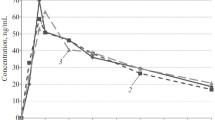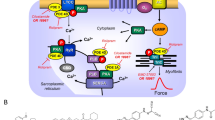Summary
In this study any changes in action potential duration or Q-T interval due to acute doses of ketanserin were monitored. The effect of a bolus dose (10 or 20 mg) followed by an infusion (10 or 20 mg over 20 minutes) of ketanserin on the Q-T interval and action potential duration was studied in six patients undergoing routine cardiac catheterization. Action potential duration was measured with a silver-silver chloride electrode catheter while heart rate was kept constant by atrial pacing and reflex effects avoided by β-adrenergic blockade. There were some prolongations of the action potential duration but they were not in excess of 40 msec and did not reach statistical significance (control 263±46.0 msec; bolus 269±52.1 msec; infusion 262±53.6 msec; nor were there any significant changes in Q-T interval. Thus acute intravenous doses of ketanserin, in the absence of hypokalaemia or other Q-T interval-prolonging drugs, have no consistent effect on Q-T interval or action potential duration; prolongation of the action potential, when it occurs, is small.
Similar content being viewed by others
References
Saman S, Thandroyen F, Opie LH. Serotonin and the heart: Effects of ketanserin on myocardial function, heart rate, and arrhythmias. J Cardiovasc Pharmacol 1985; 7(Suppl 7): S70-S75.
Symoens J. Clinical profile of a novel antihypertensive agent: Ketanserin. In: Breckenridge AM, Ramsay LE, Robertson JIS, eds. Serotonin Antagonists in Hypertension. Guildford, England: Update-Siebert Publications, 1986;72–86.
Bazett HC. An analysis of the time relations the electrocardiograms. Heart 1920; 7:353–369.
Seed WA, Noble MIM, Oldershaw P, et al. Relationship of human cardiac action potential duration to the interval between beats; implications for the validity of rate corrected QT interval (QTc). Brit Heart J 1987; 57:32–37.
Clinical Aspects of Ventricular Repolarization, International Conference on the Management of Cardiac Arrythmias. PACE 1987; 10:961–1046.
Miller GAH, Noble MIM, Papadoyannis D, et al. A cathetertip method for recording monophasic action potentials from the canine or human endomyocardium. J Physiol (Lond) 1980; 305:7–8P.
Hoffman BF, Cranefield PF, Lepeschkin E, et al. Comparison of cardiac monophasic action potentials recorded by intracellular and suction electrodes. Am J Physiol 1959; 196:1297–1301.
Franz MR, Burkhoff D, Spurgeon H, et al. In vitro validation of a new cardiac catheter technique for recording monophasic action potentials. Eur Heart J 1986; 7:34–41.
Elizinga G, Lab MJ, Noble MIM, et al. The action potential duration and contractile response of the intact heart related to the preceding interval and the preceding beat in the dog and cat. J Physiol 1981; 314:481–500.
Drake AJ, Noble MIM, Schouten V, et al. Is action potential duration of the intact dog heart related to contractility or stimulus rate? J Physiol 1982; 331:499–510.
Drake-Holland AJ, Noble MIM, Pieterse M, et al. Cardiac action potential duration and contractibility in the intact dog heart. J Physiol 1983; 345:75–85.
Bosker H, Drake-Holland AJ, ter Keurs HEDJ, et al. On the change of cardiac action potential with age: A study in dogs. Cardiovasc Res 1985; 19:674–678.
Snedecor, G, Cochran, W. Statistical Methods. Iowa State University Press, 1973.
Ball SG, Clinical pharmacology of ketanserin. In:Breckenridge AM, Ramsay LE, Robertson JIS, eds. Serotonin Antagonists in Hypertension. Guilford, England: Update-Siebert Publications, 1986.
Vanhoutte PM, Amery A, eds. Serotonin mechanisms in the cardiovascular system. J Cardiovasc Pharmacol 1985; 7(Suppl. 7):S1–S182.
Kauman AJ. A classification of heart serotonin receptors (abstr). Naunyn Schmiedebergs Arch Pharmacol 1983; 322(Suppl);R42.
Peroutka SJ, Snyder SH. Multiple serotonin receptors; differential binding of [3H]5-hydroxytryptamine, [3H]lysergic acid diethylamide and [3H]spiroperidol. Mol Pharmacol 1979; 16:687–699.
Drake-Holland AJ, Noble MM. Modulation of myocardial membrane function: Phosphorylation of membrane proteins. In: Drake-Holland AJ, Noble MIM, eds. Cardiac Metabolism. Chichester England Wiley, 1983;391–416.
Author information
Authors and Affiliations
Rights and permissions
About this article
Cite this article
Drake-Holland, A.J., Noble, M.I.M., Pugh, S. et al. Effect of intravenous ketanserin on the human action potential duration at fixed heart rate. Cardiovasc Drug Ther 2, 239–243 (1988). https://doi.org/10.1007/BF00051240
Issue Date:
DOI: https://doi.org/10.1007/BF00051240




